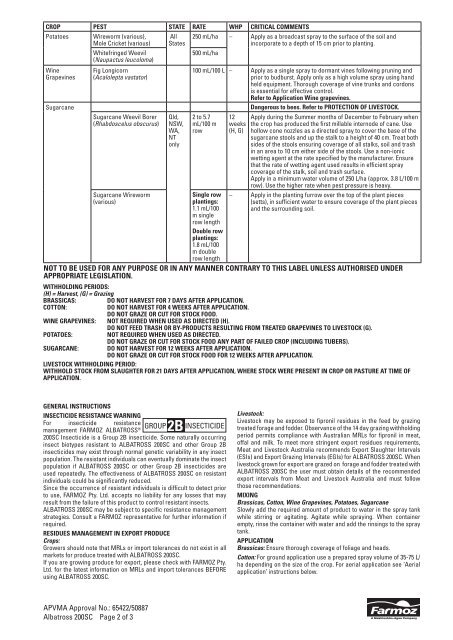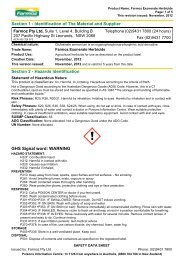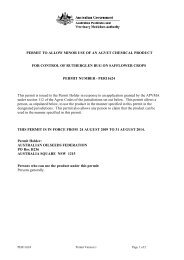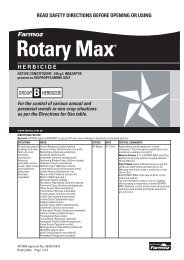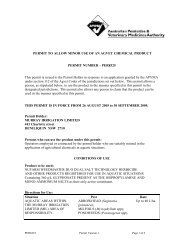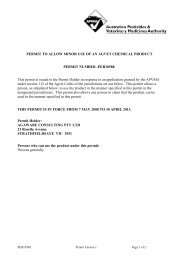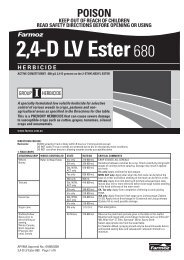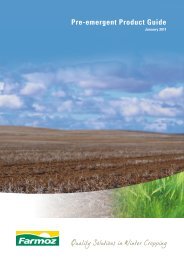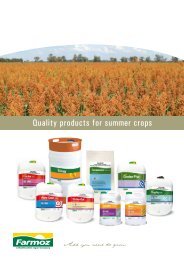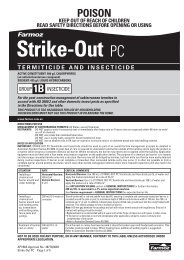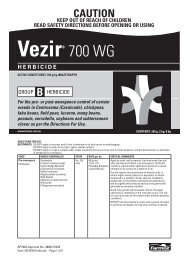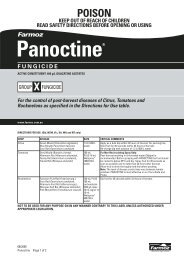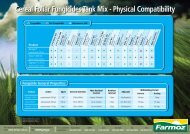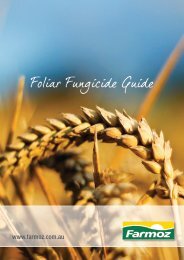Label - Farmoz
Label - Farmoz
Label - Farmoz
Create successful ePaper yourself
Turn your PDF publications into a flip-book with our unique Google optimized e-Paper software.
CROP PEST STATE RATE WHP CRITICAL COMMENTS<br />
Potatoes Wireworm (various),<br />
Mole Cricket (various)<br />
Wine<br />
Grapevines<br />
Whitefringed Weevil<br />
(Naupactus leucoloma)<br />
Fig Longicorn<br />
(Acalolepta vastator)<br />
APVMA Approval No.: 65422/50887<br />
Albatross 200SC Page 2 of 3<br />
All<br />
States<br />
250 mL/ha – Apply as a broadcast spray to the surface of the soil and<br />
incorporate to a depth of 15 cm prior to planting.<br />
500 mL/ha<br />
100 mL/100 L – Apply as a single spray to dormant vines following pruning and<br />
prior to budburst. Apply only as a high volume spray using hand<br />
held equipment. Thorough coverage of vine trunks and cordons<br />
is essential for effective control.<br />
Refer to Application Wine grapevines.<br />
Sugarcane Dangerous to bees. Refer to PROTECTION OF LIVESTOCK.<br />
Sugarcane Weevil Borer<br />
(Rhabdoscelus obscurus)<br />
Sugarcane Wireworm<br />
(various)<br />
Qld,<br />
NSW,<br />
WA,<br />
NT<br />
only<br />
2 to 5.7<br />
mL/100 m<br />
row<br />
Single row<br />
plantings:<br />
1.1 mL/100<br />
m single<br />
row length<br />
Double row<br />
plantings:<br />
1.8 mL/100<br />
m double<br />
row length<br />
12<br />
weeks<br />
(H, G)<br />
Apply during the Summer months of December to February when<br />
the crop has produced the first millable internode of cane. Use<br />
hollow cone nozzles as a directed spray to cover the base of the<br />
sugarcane stools and up the stalk to a height of 40 cm. Treat both<br />
sides of the stools ensuring coverage of all stalks, soil and trash<br />
in an area to 10 cm either side of the stools. Use a non-ionic<br />
wetting agent at the rate specified by the manufacturer. Ensure<br />
that the rate of wetting agent used results in efficient spray<br />
coverage of the stalk, soil and trash surface.<br />
Apply in a minimum water volume of 250 L/ha (approx. 3.8 L/100 m<br />
row). Use the higher rate when pest pressure is heavy.<br />
– Apply in the planting furrow over the top of the plant pieces<br />
(setts), in sufficient water to ensure coverage of the plant pieces<br />
and the surrounding soil.<br />
NOT TO BE USED FOR ANY PURPOSE OR IN ANY MANNER CONTRARY TO THIS LABEL UNLESS AUTHORISED UNDER<br />
APPROPRIATE LEGISLATION.<br />
WITHHOLDING PERIODS:<br />
(H) = Harvest, (G) = Grazing<br />
BRASSICAS: DO NOT HARVEST FOR 7 DAYS AFTER APPLICATION.<br />
COTTON: DO NOT HARVEST FOR 4 WEEKS AFTER APPLICATION.<br />
DO NOT GRAZE OR CUT FOR STOCK FOOD.<br />
WINE GRAPEVINES: NOT REQUIRED WHEN USED AS DIRECTED (H).<br />
DO NOT FEED TRASH OR BY-PRODUCTS RESULTING FROM TREATED GRAPEVINES TO LIVESTOCK (G).<br />
POTATOES: NOT REQUIRED WHEN USED AS DIRECTED.<br />
DO NOT GRAZE OR CUT FOR STOCK FOOD ANY PART OF FAILED CROP (INCLUDING TUBERS).<br />
SUGARCANE: DO NOT HARVEST FOR 12 WEEKS AFTER APPLICATION.<br />
DO NOT GRAZE OR CUT FOR STOCK FOOD FOR 12 WEEKS AFTER APPLICATION.<br />
LIVESTOCK WITHHOLDING PERIOD:<br />
WITHHOLD STOCK FROM SLAUGHTER FOR 21 DAYS AFTER APPLICATION, WHERE STOCK WERE PRESENT IN CROP OR PASTURE AT TIME OF<br />
APPLICATION.<br />
GENERAL INSTRUCTIONS<br />
INSECTICIDE RESISTANCE WARNING<br />
For insecticide resistance<br />
management FARMOZ ALBATROSS ®<br />
2B INSECTICIDE<br />
GROUP<br />
200SC Insecticide is a Group 2B insecticide. Some naturally occurring<br />
insect biotypes resistant to ALBATROSS 200SC and other Group 2B<br />
insecticides may exist through normal genetic variability in any insect<br />
population. The resistant individuals can eventually dominate the insect<br />
population if ALBATROSS 200SC or other Group 2B insecticides are<br />
used repeatedly. The effectiveness of ALBATROSS 200SC on resistant<br />
individuals could be significantly reduced.<br />
Since the occurrence of resistant individuals is difficult to detect prior<br />
to use, FARMOZ Pty. Ltd. accepts no liability for any losses that may<br />
result from the failure of this product to control resistant insects.<br />
ALBATROSS 200SC may be subject to specific resistance management<br />
strategies. Consult a FARMOZ representative for further information if<br />
required.<br />
RESIDUES MANAGEMENT IN EXPORT PRODUCE<br />
Crops:<br />
Growers should note that MRLs or import tolerances do not exist in all<br />
markets for produce treated with ALBATROSS 200SC.<br />
If you are growing produce for export, please check with FARMOZ Pty.<br />
Ltd. for the latest information on MRLs and import tolerances BEFORE<br />
using ALBATROSS 200SC.<br />
Livestock:<br />
Livestock may be exposed to fipronil residues in the feed by grazing<br />
treated forage and fodder. Observance of the 14 day grazing withholding<br />
period permits compliance with Australian MRLs for fipronil in meat,<br />
offal and milk. To meet more stringent export residues requirements,<br />
Meat and Livestock Australia recommends Export Slaughter Intervals<br />
(ESIs) and Export Grazing Intervals (EGIs) for ALBATROSS 200SC. When<br />
livestock grown for export are grazed on forage and fodder treated with<br />
ALBATROSS 200SC the user must obtain details of the recommended<br />
export intervals from Meat and Livestock Australia and must follow<br />
those recommendations.<br />
MIXING<br />
Brassicas, Cotton, Wine Grapevines, Potatoes, Sugarcane<br />
Slowly add the required amount of product to water in the spray tank<br />
while stirring or agitating. Agitate while spraying. When container<br />
empty, rinse the container with water and add the rinsings to the spray<br />
tank.<br />
APPLICATION<br />
Brassicas: Ensure thorough coverage of foliage and heads.<br />
Cotton: For ground application use a prepared spray volume of 35-75 L/<br />
ha depending on the size of the crop. For aerial application see ‘Aerial<br />
application’ instructions below.


